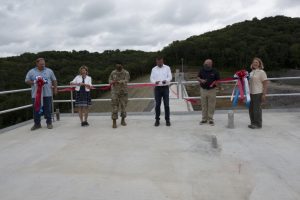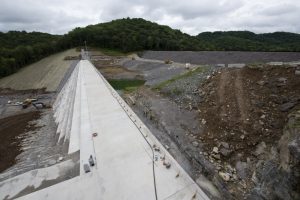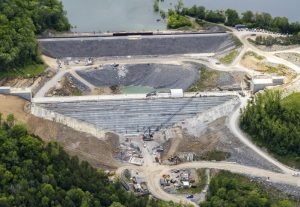June 29, 2020
By: Lee Roberts, NASHVILLE DISTRICT PUBLIC AFFAIRS
Officials celebrated completion of the last phase of repairs for the $353 million Center Hill Dam Safety Rehabilitation Project today (Wednesday) where the Corps of Engineers recently finished constructing a roller compacted concrete berm to reinforce the auxiliary dam at Center Hill Lake, a secondary earthen embankment that fills a low area in the landscape just east of the main dam.
“In 2005 Center Hill Dam was classified as a high risk dam by the U.S. Army Corps of Engineers and an independent panel of dam safety experts. This classification led the Corps of Engineers to execute a dam safety remediation project consisting of three major construction projects,” said Lt. Col. Sonny Avichal, U.S. Army Corps of Engineers Nashville District commander. “Today we celebrate the achievements of many personnel who have worked on the dam since 2005.”
Avichal joined Tennessee District 40 Rep. Terri Lynn Weaver; and Steve Kohler, president and chief executive officer of Thalle Construction Corporation; in a ribbon-cutting, signifying the completion of the RCC berm and the overarching dam safety rehabilitation project.
Weaver, who also sang the National Anthem, introduced her husband Mike and spoke about how amazing the lake is and how the local community is excited about the completion of the rehabilitation, and return to normal lake levels.
“We live just down the river, and so we have literally watched years of this step-by-step progress be made, and have literally just seen the transformation,” Weaver said. “And I can tell you there was a whole lot of rock, and a whole lot of cement, and a whole lot of work being done here.”
Weaver stressed that this is a huge project that she saw develop chapter by chapter, one that’s been years in the making. “But it’s worth the effort, especially for us folks downstream. Everyone here is a part of this; you are a part of making history.”
Center Hill is a multi-purpose dam and reservoir on the Caney Fork River, a major tributary of the Cumberland River, located about 60 miles east of and 100 river miles upstream of Metropolitan Nashville. Center Hill reservoir is the Nashville District’s second largest flood storage reservoir. Originally constructed for flood risk reduction and hydropower, the dam and reservoir also provide water supply, recreation, and water quality benefits to the region.
In 2005, the Corps of Engineers classified Center Hill Dam as high risk with an urgent need for dam safety remediation. In 2008 the Corps lowered the lake about 18 feet as a risk reduction measure. The Center Hill Dam Safety Rehabilitation Project involved three major contracts and construction efforts.
Advanced Construction Techniques completed the first major construction contract from 2008 to 2010, a $107 million grouting project at the main dam embankment and left rim. The contractor pumped flowable concrete into the foundation to fill voids. The grouting program provided valuable information on the extent of rock solution features to facilitate the design depth and extent of the subsequent barrier wall.
During the second major construction contract from 2012 to 2015, Bauer Foundation Corporation installed a $122 million 2.5-feet thick foundation cut-off wall. The Corps constructed it vertically along the embankment in overlapping rectangular columns as deep as 308 feet from the top of the dam, deep into the solid-rock foundation.
“The barrier wall provides a permanent ‘barrier’ to potentially harmful seepage beneath the main dam earthen embankment,” said Corps of Engineers Retiree Linda Adcock, who served as the Nashville District project manager when the Corps finished work on the barrier wall in 2015.
Construction of the RCC Berm completes the final major construction contract to remediate the Center Hill project. As a result of this completion milestone, visitors to Center Hill Lake are able to enjoy normal pool levels this recreation season for the first time in 15 years.
The recently completed construction of the $50 million RCC berm stabilizes the left rim and reduces risk of both an internal erosion foundation failure and a potential overtopping failure mode at the saddle dam. The Corps awarded the contract to Thalle Construction Corporation in 2016.
Kohler thanked the Corps of Engineers, stakeholders, his dedicated team, partners, and sub-contractors that played key roles in the project.
He explained that from the onset of the project Thalle had to establish a suitable location for the batch plant and aggregate stockpiles that would be accessible for deliveries, power, and water supply. He said conveyance of the RCC material to the structure would be instrumental to the success of the RCC placement. Another issue involved placing concrete during the summer time, he added.
“The Corps’ requirement for temperature of the RCC mix at the time of placement is 70 degrees. The problem lies when it’s 95 degrees outside and your aggregates are baking in the sun and just the heat buildup through the mix… it becomes extremely problematic,” Kohler said.
Thalle Construction Company remedied the situation by pumping -60 degree water from the depths of Center Hill Lake through chillers to reduce the temperature to 37 degrees. They used the cooled water in the batching process and for chilling the aggregates, and successfully used nitrogen in the batching process to further cool the mix.
“In our business, figuring out how to peel the apple differently or reinvent a mouse trap is key to the competitive advantages that we have,” Kohler said.
RCC is a mix of cement and fly ash, water, sand, aggregate and common additives, but contains much less water. It reduces the thermal loads on the dam and reduces the potential for thermal cracking to occur. It is drier and essentially has no slump.
During construction, a conveyer delivered RCC to the work platform. Small bulldozers or specially modified asphalt pavers spread the mixture, and construction crews then compacted it with vibratory rollers.
The RCC berm reinforces the earthen saddle dam embankment and is designed and built to overtop in the event an extreme flood erodes the fuse plug for spillway capacity.
“In February of 2019, we witnessed the second highest lake level since the lake was impounded in 1948, so the need for this concrete structure is very relevant,” Avichal said.
Jill Kelley, Nashville District project manager, said she is happy the RCC berm construction is complete, and she knows that the local community is thrilled about the completion of the project.
“So we are able to return to normal operations and enjoy the recreational uses provided by Center Hill Dam,” Kelly said.






